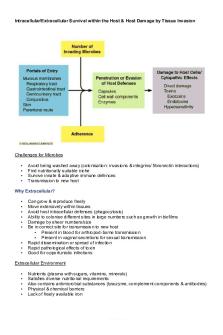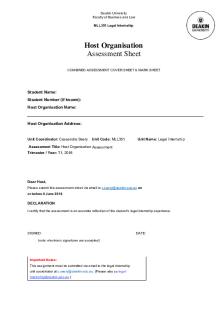Intracellular:Extracellular Survival within the host & Host Damage by Tissue Invasion PDF

| Title | Intracellular:Extracellular Survival within the host & Host Damage by Tissue Invasion |
|---|---|
| Course | Clinical Microbiology and Immunology |
| Institution | University of East London |
| Pages | 4 |
| File Size | 153.1 KB |
| File Type | |
| Total Downloads | 52 |
| Total Views | 128 |
Summary
Download Intracellular:Extracellular Survival within the host & Host Damage by Tissue Invasion PDF
Description
Intracellular/Extracellular Survival within the Host & Host Damage by Tissue Invasion
Challenges for Microbes • • • •
Avoid being washed away (colonisation: invasions & integrins/ fibronectin interactions) Find nutritionally suitable niche Survive innate & adaptive immune defences Transmission to new host
Why Extracellular? • • • • • •
• • •
Can grow & reproduce freely Move extensively within tissues Avoid host intracellular defenses (phagocytosis) Ability to colonise different sites in large numbers such as growth in biofilms Damage by sheer numbers/size Be in correct site for transmission to new host • Present in blood for arthropod-borne transmission • Present in vaginal secretions for sexual transmission Rapid dissemination or spread of infection Rapid pathological effects of toxin Good for opportunistic infections
Extracellular Environment • • • • •
Nutrients (plasma with sugars, vitamins, minerals) Satisfies diverse nutritional requirements Also contains antimicrobial substances (lysozyme, complement components & antibodies) Physical & chemical barriers Lack of freely available iron
Why Intracellular? • • • • • • • • •
Immunologically protected – Antibodies, complement etc Escape from host surveillance systems Easy dissemination around body Can parasitise host for survival (smaller genome) Need specialised methods to survive within phagosome/phagolysosome Need mechanism to escape phagolysosome Refined host-microbial communication to subvert cell for own survival Often seen in host adapted pathogens Often seen for persisting infections
Intracellular pathogens (both obligate and facultative) must be able to avoid being killed within phagolysosomes. This can occur from by-passing or lysing these vesicles and then residing free in the cytoplasm. Alternatively, they can survive in phagosomes (fusion of phagosomes with lysosomes may be inhibited) or the organism may be resistant to degradative enzymes (if fusion with lysosomes occurs). Intracellular Mechanisms • • • • • • • • • •
Microbial mediated internalisation Prevention of lysosomal fusion – Brucella, Salmonella, M. tuberculosis, Chlamydiae Survival following lysosomal fusion – Coxiella Escape from phagolysosome into cytoplasm – Rickettsia Most show continued host-microbial interaction using secretion systems Most prevent autolysis of host cell Many persistent/chronic infections Need cellular immune response (cytotoxicT cells/activated macrophages) for clearance Often see chronic granulomatous reaction to isolate pathogen Often need survival form for non-intracellular transfer
The Immune System in Resistance to Infection Extracellular pathogens: Antibodies cause lysis of the organism and/or their opsonization by phagocytes at which point they are rapidly killed. Intracellular pathogens: Primarily killed by cell mediated immunity.
Compare and Contrast Intracellular and Extracellular pathogens giving examples of the mechanisms of causing host pathology Intro Pathogens are biological agents that cause disease or illness to their host. They do so by invading their host, causing damage to host tissue in the process, or by secreting toxins that cause damage to host tissue.
1. Extracellular pathogen – a bacterial pathogen that can grow and reproduce freely and may move extensively within the tissues of the body. (A more narrow meaning and one that we will use in this class- to describe the relationship between a pathogenic bacterium and the professional phagocytic cells (the neutrophils, monocytes and macrophages). In this context, an extracellular pathogen is one that cannot survive inside the phagocyte once it has been ingested. 2. Intracellular pathogens –pathogens that can live inside of host cells, especially phagocytes.
Extracellular Pathogens Extracellular pathogens can grow and reproduce freely meaning that they are able to replicate outside the host cells in regions such as the blood, the connective tissues and in lumens or airways. Typically, these pathogens multiply in the host at extracellular sites such as mucosal surfaces, vascular, lymphatic, and body cavity fluids, and in interstitial spaces Many different species of extracellular bacteria are pathogenic, and disease is caused by two principal mechanisms after they gain entry into the host. First, these bacteria induce inflammation, which results in tissue destruction at the site of infection. Second, bacteria produce toxins, which have diverse pathologic effects. Extracellular pathogens can also evade phagocytosis, which is a host defence mechanism where neutrophils are recruited to site of infection. Staphylococcus aureus, Streptococcus pyogenes, Pseudomonas aeruginosa, Escherichia coli are typical examples of bacteria which have been labeled extracellular pathogens. Extracellular pathogens use virulence mechanisms to evade the antimicrobial capabilities of humoral immunity and phagocytosis thus promoting extracellular multiplication. Virulence Factors • • •
Staphylococcus aureus – Toxic shock synd. Toxin Strep pyogenes – streptolysin toxins Pseudomonas aeruginosa – exotoxins
Intracellular Pathogens Pathogenic intracellular bacteria are resistant to degradation within phagocytes. They are able to escape from host surveillance systems and even replicate within phagocytes because these microbes are able to find a niche where they are inaccessible to circulating antibodies, their elimination requires the mechanisms of cell-mediated immunity
To establish an infection, these pathogens have to make contact with the appropriated type of host cell that affords suitable intracellular conditions for growth. Intracellular bacterial pathogens use a wide range of host cells both professional (macrophages) and non-professional phagocytes like epithelial and endothelial cells and hepatocytes. After entering the target host cell, the intracellular pathogen may follow diverse vacuolar or cytosolic pathways. Mycobacterium tuberculosis, Salmonella enterica Brucella abortus, Chlamydia trachomatis Extracellular vs. Intracellular In the extracellular environment, pathogens have the ability to grow and reproduce freely and move extensively within the tissues to avoid host intracellular defences such as phagocytosis. They are also able to colonise different sites in large numbers. Whilst extracellular pathogens evade immune response by preventing phagocytosis and complement activation, intracellular pathogens use phagocytosis to gain entry into the host. They then use mechanisms to escape phagocytes or survive within the phagosome. Mechanism of causing host pathology varies within extracellular and intracellular pathogens. Extracellular pathogens cause host infections through secretion of toxins whereas intracellular pathogens cause infections though tissue damage by tissue invasion. Immune response to extracellular pathogens is more of a humoral response whilst intracellular pathogens need cell mediated responses. Extracellular pathogens are required to express features to help them attach to the host (pilli) and features to help them move within the tissue (flagella). They control the expression of these features by turning on and off certain genes. Intracellular pathogens are easily transported around the body by the cells that they have invaded and does not require the expression if these features to aid transmission....
Similar Free PDFs

Host manipulation by parasite
- 30 Pages

Host Hardening - Brief
- 1 Pages

Git-host - sadd
- 3 Pages

Class Notes Host Factors
- 2 Pages

Pengertian Host Hardening
- 10 Pages

Ch13 The Survival Game
- 3 Pages
Popular Institutions
- Tinajero National High School - Annex
- Politeknik Caltex Riau
- Yokohama City University
- SGT University
- University of Al-Qadisiyah
- Divine Word College of Vigan
- Techniek College Rotterdam
- Universidade de Santiago
- Universiti Teknologi MARA Cawangan Johor Kampus Pasir Gudang
- Poltekkes Kemenkes Yogyakarta
- Baguio City National High School
- Colegio san marcos
- preparatoria uno
- Centro de Bachillerato Tecnológico Industrial y de Servicios No. 107
- Dalian Maritime University
- Quang Trung Secondary School
- Colegio Tecnológico en Informática
- Corporación Regional de Educación Superior
- Grupo CEDVA
- Dar Al Uloom University
- Centro de Estudios Preuniversitarios de la Universidad Nacional de Ingeniería
- 上智大学
- Aakash International School, Nuna Majara
- San Felipe Neri Catholic School
- Kang Chiao International School - New Taipei City
- Misamis Occidental National High School
- Institución Educativa Escuela Normal Juan Ladrilleros
- Kolehiyo ng Pantukan
- Batanes State College
- Instituto Continental
- Sekolah Menengah Kejuruan Kesehatan Kaltara (Tarakan)
- Colegio de La Inmaculada Concepcion - Cebu









